#paguma
Text

Masked Palm Civet
51 notes
·
View notes
Text
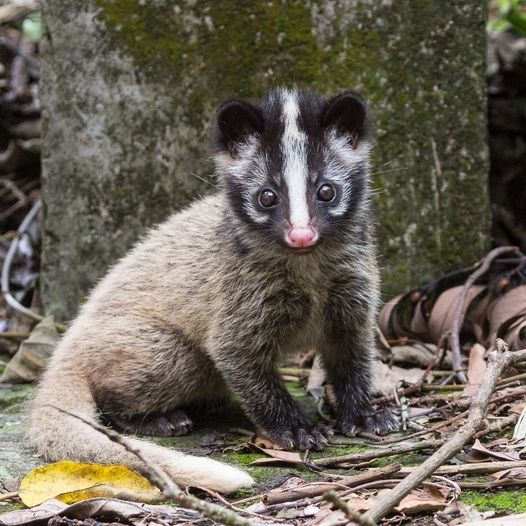
Masked Palm Civet (Paguma larvata), baby, family Viverridae, found across much of South and SE Asia
photograph by andrewhardacre
362 notes
·
View notes
Text
TS Jenna Creed loves anal fuck
Dando pro meu primo dotado
Sexy milf India Summer sucks and fucks BBC
POV: Loser Worships Big Fat Ebony Ass - Femdom
somali ass
KT So showing huge camel toe
Hot Blonde Strip Show And Cam Play
Indian gay whore
Milf with amazing legs spied under table
Chubby spanish gf with huge breasts fucked
#avocation#watchmaking#chapelry#Tihwa#glass-coach#subcordately#placemen#rally#latewood#Paguma#incarcerating#rusticities#colporrhaphy#hymnologist#Pyramidella#vehemence#acetiam#vassaless#Landri#unadmiringly
0 notes
Text
Julia Ann: In With The New - Brazzers
Tributo a las tetonas
Husband cums while watching wife fuck bull in theater room
Big Girls Rides Dick Bouncing On Top Bareback Making It Fill Her Fat Pussy With Cum
Ms Kayz last early morning blowjob
Milf solo big tit dildo When we got him rigid we let him drill our
Foxy Boxing with Paris Knight and Paris Love
Busty Milfs Julia Ann Cherie Deville & Aaliyah Tongue Fuck!
who has fucked a gripping pussy?
Smoking, Stripping, and Shaking my PAWG ass
#latewood#Paguma#incarcerating#rusticities#colporrhaphy#hymnologist#Pyramidella#vehemence#acetiam#vassaless#Landri#unadmiringly#collineation#comedial#glycopexis#scissures#antichurch#circulatory#pseudopodia#knockless
0 notes
Note
Hi hello any idea what this little guy is? The only source I found is pinterest and it just says civet but not what kind
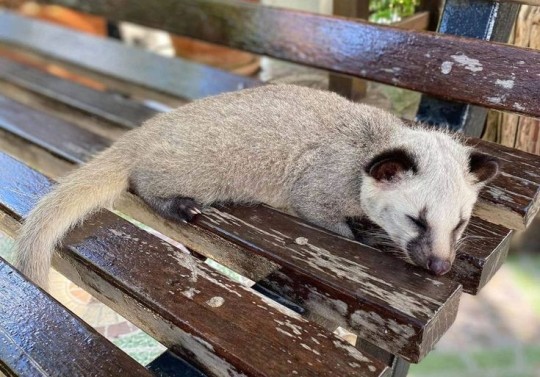
I do! That’s a masked palm civet (Paguma larvata)!
Sure, this particular guy doesn’t have much of a mask. But that’s because masked palm civets come in an impressive variety of coat colors! Here are a few of them:

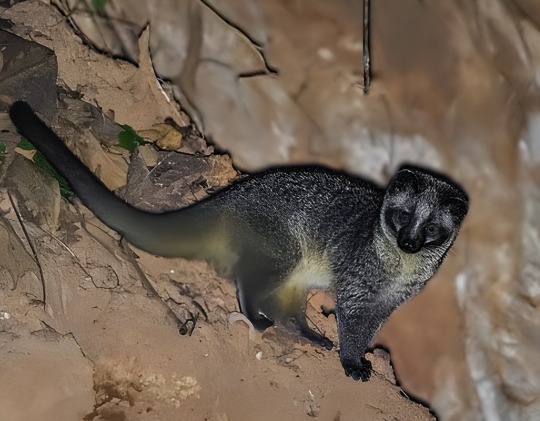


As of now, six different subspecies of masked palm civet are formally recognized, but as many as sixteen have been described! So this little guy just happened to be born with a particularly light coat, especially on the face. I wouldn’t rule out them being partially leucistic!
155 notes
·
View notes
Text
Ville rovdyr

league-scientifique - 2 years ago
Ekte eventyr er de facto foreslått i navnet på bevaring av sjeldne rovdyr i Kina. Vi er på sporet av karismatiske rovdyr, fra mustelider opp til ville hunder som huser ville regioner i Sentral-Kina. Gjør en forskjell for å styrke bevaringsfamaen til innfødt dyreliv. La oss gjennomføre banebrytende prosjekt for å forstå sjeldne arter som dhole Cuon alpinus og grevling Arctonyx sp. , asiatisk bjørn Ursus thibetanus og weasels Mustela sibirica med alle registrert fra vill Hupeh, f.eks. Shennongjia Evergreen Forest og innenfor reservatene til økosystemet til Daba Massif. Mer forskning er nødvendig for å forstå populasjoner av Melogale sp. og uidentifiserte mårarter. Sentral-Kina-fjellene representerer potensielle siste tilfluktssteder for ville hundedyr som revlignende skapninger, som er ukjent for vitenskapen og sjeldne mustelidae nevnt tidligere. Flott jobb ville være å avsløre naturen til katter som gullkatten Catopuma temminicki og civets som Paguma larvata. Vi kan også jobbe med andre pattedyr fra endemiske aper, via leporider og relikviegnagere. Etterpå kan økologi- og bevaringsprosjekt for ville hunder være banebrytende for dette landskapet og kinesisk mammalogi. Ytterligere prosjekter settes pris på. Men det vi trenger å bevare for fremtidige generasjoner er natur- og kulturarven i denne delen av Czung Kuo er innovativt samarbeid. På den arkaiske basaren leter vi etter etnozoologiske gjenstander. En annen utfordring er å dempe konflikter mellom dyreliv og mennesker i ville økosystemer. Notabene, så vidt vi vet er det nødvendig med flere studier, men science fiction fyller kanskje noen huller. La oss gjennomføre milepælsaktivitet innen naturressursforvaltning i naturområdene Hupeh, Chongqing og Henan. Lagt ut av lisensiert biolog og pro-vitenskapelig forfatter Tomasz Pietrzak som @gnhi-prosjekt. Kontakt med forfatter på echl.league.scientifc på gmail.com. Lagt ut under Creative Commons License.
link>https://www.sporenbiolog.no/Topic/Posts/143942

1 note
·
View note
Photo

お風呂屋さんの帰りにハクビシンに遭遇した!ねこにしてはひょろりとしてて、フェレットにしてはでかく、やたら毛並みが良かった
I ran into Paguma larvata on my way home from public bath.
0 notes
Photo


Baby masked palm civet (Paguma larvata)
Andrew Hardacre Photography
1K notes
·
View notes
Text
Год пандемии COVID-19 и почему мы сами ответственны за неё
Сегодня мы можем “отметить” годовщину с официального начала пандемии COVID-19, когда гендиректор ВОЗ Тедрос Аданом Гебреисус объявил об этом на пресс-конференции в Женеве 11.03.2020г.
Мы пришли к выводу, что ситуацию с COVID-19 можно охарактеризовать как пандемию..И мы крайне обеспокоены как пугающими темпами распространения вируса, так и пугающим бездействием... В ближайшие дни и недели мы ожидаем, что количество случаев заражения COVID-19, количество вызванных им смертей и количество охваченных вспышкой заболевания стран продолжат увеличиваться...

Я специально не писал в течении года об этом заболевании, т.к. очень многие моменты были специально раздуты или, наоборот, скрывались от общественности, тогда как полезной информации о свойствах возбудителя и путях его передачи было мало. Пробовались различные схемы лечения, из запасников извлекались давно позабытые препараты, которые могли потенциально оказать положительный эффект, что в дальнейшем во многих случаях не оправдалось и, наконец, на рынок вышло множество вакцин с различным механизмом действия, которые мы фактически тестируем на огромной популяции добровольцев и ждём, что из этого выйдет. Медлить нельзя, но и спешка может оказаться фатальной, ведь на кону стоят наши жизни.
В этой статье я буду в основном писать об истоках. Ничего не меняется. Наше потребительское отношение к природе приносит свои плоды, и, к сожалению, они поражены порчей.
Как известно, это вирусное заболевание относится к зоонозным инфекциям, т.е. передаваемым от животных к человеку. Животные служат естественным резервуаром (источником) возбудителей, а человек может заразиться от животных, например, при близком контакте с ними, или употребляя в пищу их мясо, или при использовании предметов, изготовленных из кожи или шерсти больных животных. О некоторых зоонозах, таких как чума, бешенство, сибирская язва, мы с вами хорошо знаем, но большинство из них по-прежнему остаются неизученными достаточно. А ведь вирусы и бактерии интенсивно мутируют. Откуда ждать следующего “удара”, мы можем только догадываться.
Переносят инфекции обычно представленные ниже животные

однако есть и более специфические варианты, как в случае с коронавирусом, - летучие мыши. И в данном случае именно большой подковонос из рода Rhinolophus. SARS-CoV-2 был впервые зарегистрирован осенью 2019 года в китайском Ухане (провинция Хубэй).
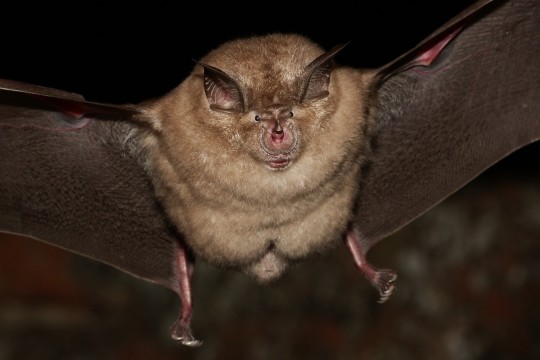
Ну не красавчик ли?
Ещё в 2013 г. было проведено исследование о сравнении обычных грызунов с летучими мышами в плане распространения вирусных инфекций. Используя обширную базу данных, авторы постарались учесть множество факторов в пределах каждой группы переносчиков вирусов, в частности процент видов, имеющих перекрывающиеся ареалы, размер и плотность колоний, длительность жизненных циклов, массу тела, количество приплода в год, продолжительность спячки и степень миграции. Итог работы: летучие мыши обыграли своих “коллег” как по количеству (и опасности) переносимых возбудителей, так и по потенциальным возможностям в их распространении. Но есть одно “но”: шанс встретиться с грызунами у человека намного выше, чем с тем же подковоносом. Летучие мыши хоть и распространены в мире, но их колонии расположены в пещерах, вдали от мест обитания людей. По крайней мере, так оно и было до недавнего времени.
Вирус SARS-Cov-2, возбудитель COVID-19, на 96% идентичен вирусу подковоносых летучих мышей, однако эволюционно отделился от него еще 40-70 лет назад, иными словами, если коронавирус и произошел от летучих мышей, для того, чтобы вирус получил способность передаваться человеку, его строение должно было видоизмениться в организме какого-то другого животного, сыгравшего роль посредника. Вероятнее всего ими стали гималайские циветы (Paguma larvata). Идентичность белка-шипа S коронавируса гималайской циветы и SARS-CoV, выделенного у человека, составляет 98%, отчетливо указывая на то, что именно циветы были промежуточными хозяевами этого вируса.
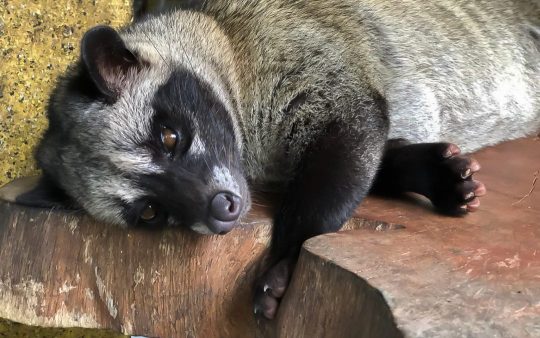
Этих зверьков используют в пищу, они продаются на влажных рынках и в качестве блюда подаются в ресторанах

Хотя и летучих мышей также активно употребляют в пищу
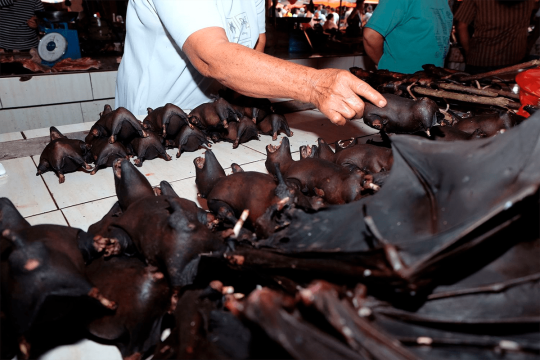
Кроме коронавирусов летучие мыши являются природным резервуаром для большого числа других опасных для человека вирусов. Вирус Эбола, относящийся к семейству филовирусов (Filoviridae), вызывает одноименную геморрагическую лихорадку у высших приматов и происхоит от ангольского складчатогуба (Mops condylurus), его промежуточный хозяин до сих пор неизвестен. Вирусы Хендра и Нипах, относящиеся к роду Henipavirus, перешли к нам от представителей семейства крылановых (Pteropodidae). Вирус Хендра поражает людей и лошадей, вызывая кровоизлияния, отек легких и в тяжелых случаях вирусный менингит, а вирус Нипах у людей приводит к респираторным заболеваниям и нередко тяжелому воспалению головного мозга (энцефалиту). Вирус, вызывающий ближневосточный респираторный синдром (MERS), пришел от представителя футлярохвостых летучих мышей, предположительно от могильного мешкокрыла (Taphozous perforatus). Здесь промежуточный хозяин - одногорбый верблюд, дромадер (Camelus dromedarius).

Благодаря адаптивным особенностям своего иммунитета, в подробности функционирования которого мы с вами не будем вдаваться в этой статье, летучие мыши стали хорошо приспособленными к патогенам, это настоящие передвижные лаборатории по культивированию возбудителей, и они представляют опасность как для других видов животных, так и для человека.
Однако истребление летучих мышей не спасет нас от инфекций. Напротив, массовое уничтожение и их изгнание из привычной среды обитания приведет к еще более тяжелым последствиям. Около 70% из 14 тысяч особей летучих мышей насекомоядны, а многие крылатые или ночные насекомые, поедаемые мышами, в свою очередь сами являются разносчиками болезней, к примеру, малярии или лихорадки денге. Летучие мыши также - активные опылители для цветов.
Именно вторжение человека в естественную среду обитания летучих мышей, их появление в больших городах, распространение их продуктов жизнедеятельности рядом с людьми, привело к тому, что мы имеем на данный момент - вспышку нового заболевания, буквально парализовавшего мировую экономику. Надеюсь, что после этой небольшой статьи, вы пришли к пониманию того, что эта тенденция продолжится, если мы не внесём коррективы в свой образ жизни.
Спасибо за внимание! Буду благодарен за репост ;)
20 notes
·
View notes
Photo
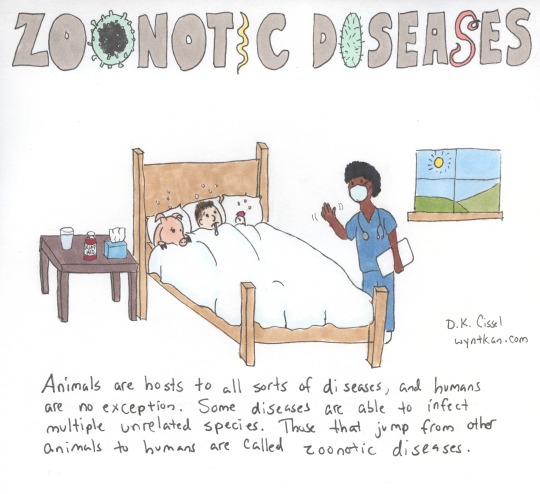
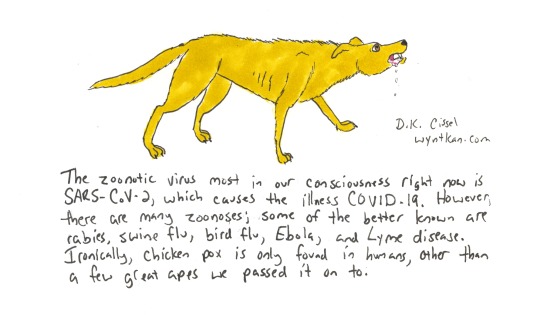
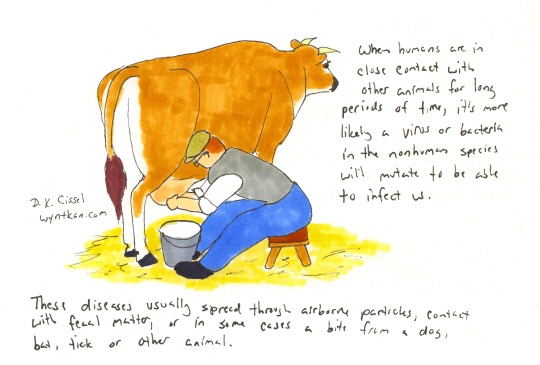
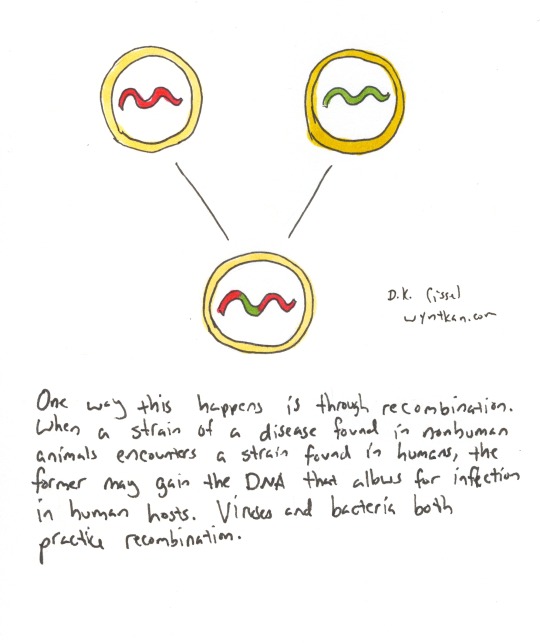
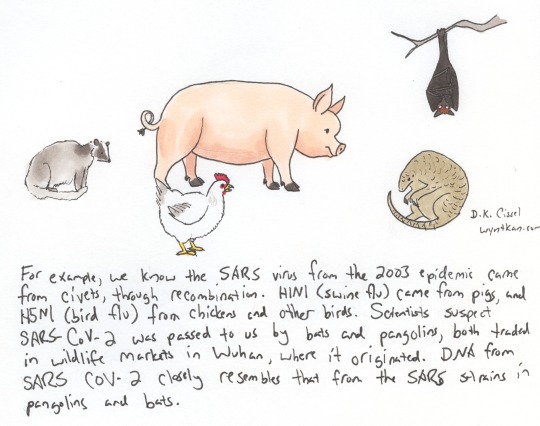


I actually had a different multi-page comic prepped for today, but over the weekend I got a wild hare to do something on topic right now. So if you've ever wondered how a disease can jump from other animals to us, now you know!
Species portrayed: Rabies virus (Rabies lyssavirus), SARS-CoV-2, Lyme disease (Borrelia sp.), Ebola (Ebolavirus sp.), human (Homo sapiens), domestic pig, (Sus scrofa domesticus) domestic chicken (Gallus gallus domesticus), domestic dog (Canis lupus familiaris), domestic cow (Bos taurus), masked palm civet (Paguma larvata), Chinese pangolin (Manis pentadactyla), large flying fox (Pteropus vampyrus), domestic cat (Felis catus), Senegal parrot (Poicephalus senegalus), bearded dragon (Pogona sp.), domestic rabbit (Oryctolagus cuniculus domesticus)
(Just a reminder that I have stickers and other fun merch at my Redbubble store, and you can also tip me for my work at my Ko-Fi! Like many people, my income has been pretty badly affected by current circumstances, so every little boost will help.)
Transcript under cut.
[Title: Zoonotic Diseases - the second O and the I in Zoonotic, and the I and season S in Diseases have been replaced by drawings of bacteria and viruses]
[First panel: A doctor in scrubs and carrying a chart waves to a man, a pig and a chicken all laying sick in bed. A table by the bed holds tissues, cough medicine and a glass of water. The window nearby shows a view out onto a sunny landscape.]
Animals are hosts to all sorts of diseases, and humans are no exception. Some diseases are able to infect multiple unrelated species. Those that jump from other animals to humans are called zoonotic diseases.
[Second panel: A yellow short-haired dog snarls and foams at the mouth.]
The zoonotic virus most in our consciousness right now is SARS-CoV-2, which causes the illness COVID-19. However, there are many zoonoses; some of the better known are rabies, swine flu, bird flu, Ebola, and Lyme disease. Ironically, chicken pox is only found in humans, other than a few great apes we passed it on to.
[Third panel: a man sits on a stool while milking a Jersey cow into a pail.]
When humans are in close contact with other animals for long periods of time, it’s more likely a virus or bacteria in the nonhuman species will mutate to be able to infect us. These diseases usually spread through airborne particules, contact with fecal matter, or in some cases a bite from a dog, bat, tick or other animal.
[Fourth panel: Three circles with squiggles inside them represent viruses. One has a red squiggle, another has a green squiggle, and lines from these two point to the third which has a red and green squiggle.]
One way this happens is through recombination. When a strain of a disease found in nonhuman animals encounters a strain found in humans, the former may gain the DNA that allows for infection in human hosts. Viruses and bacteria both practice recombination.
[Fifth panel: Several animals are on a blank background, including a masked palm civet, a domestic pig, a domestic chicken, a Chinese pangolin, and a large flying fox bat.]
For example, we know the SARS virus from the 2003 epidemic came from civets, through recombination. H1N1 (swine flu) came from pigs, and H5N1 (bird flu) from chickens and other birds. Scientists suspect SARS-CoV-2 was passed to us by bats and pangolins, both traded in wildlife markets in Wuhan, where it originated. DNA from SARS-CoV-2 closely resembles that from the SARS strains in pangolins and bats.
[Sixth panel: More animals on a blank background, including a Senegal parrot sitting on the back of a great dane, a bearded dragon, a domestic cat, and a domestic rabbit.]
Some worry whether zoonoses like SARS-C0V-2 can infect their pets. While there’s a small chance you could pass avian flu to pet birds, and some other pets like guinea pigs occasionally catch human respiratory illnesses, it’s not too common. If your pet isn’t regularly around lots of other animals in public they’re not likely to catch something to give to you. Just keep your pets’ vaccination up to date, and try to avoid kisses and other close contact when either of you are sick. It may be good to not let strangers pet your dog during the pandemic, as the virus could sit in the dog’s fur and then pass to you when you pet them, though it’s less of a risk than direct human to human contact.
[Seventh panel: A golden retriever in green scrubs and a stethoscope sits looking at the viewer. Next to her is a sign that says “Wash hands! Clean everything! Lots of space! Good hygiene! Let wild animals stay wild!”]
How do we prevent zoonoses? By limiting close exposure to wild animals, and keeping all captive animals in clean, uncrowded quarters. Treat sick animals as soon as possible. If you handle animals, even pets, wash your hands thoroughly before eating, drinking, or otherwise putting your hands near your face. Be familiar with zoonoses that the animals in your life may be susecptible to so you can all stay healthy!
35 notes
·
View notes
Text

Yan qing with masked palm civet (Paguma larvata); the assassin of Shinjuku with invasive species of Shinjuku.
8 notes
·
View notes
Photo
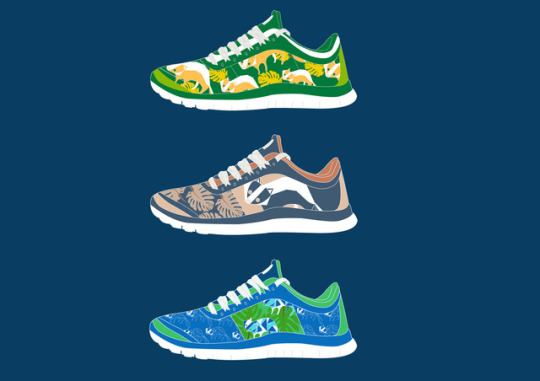
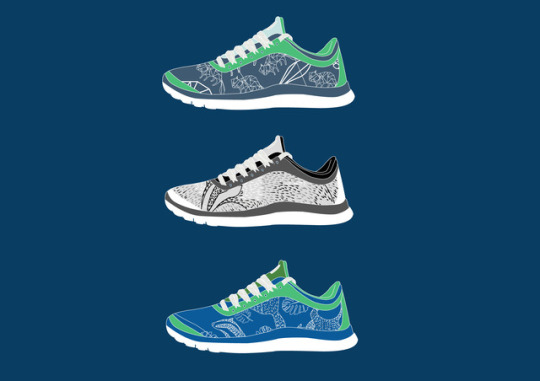
夜行性 Nocturnal
在夜間活動 擁有靈敏的嗅覺 聽覺 觸覺
客層目標:夜晚活動的年輕人 街舞 滑板 夜騎
風格:休閒 街頭
以台灣特有種-白鼻心為設計概念,白鼻心為夜行性動物,呼應所設定的客群類型,透過結合光纖維,讓鞋面設計的圖案能夠於夜間活動時為穿者多一層保護,也進而提倡我們所關注的動物保育議題。
1 note
·
View note
Text

It’s me again. @paguma
#gay#boy#men#gayart#gayblog#self portrait#portraits#portrait#portrait photography#portrait photo editing#retouchingacademy#retoucher#retouched
3 notes
·
View notes

